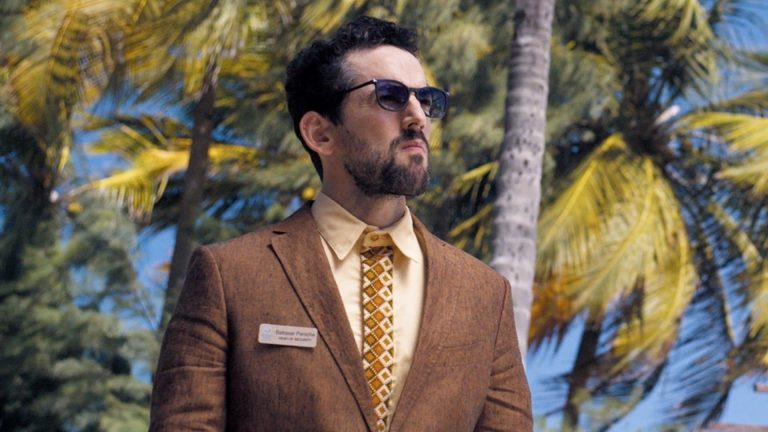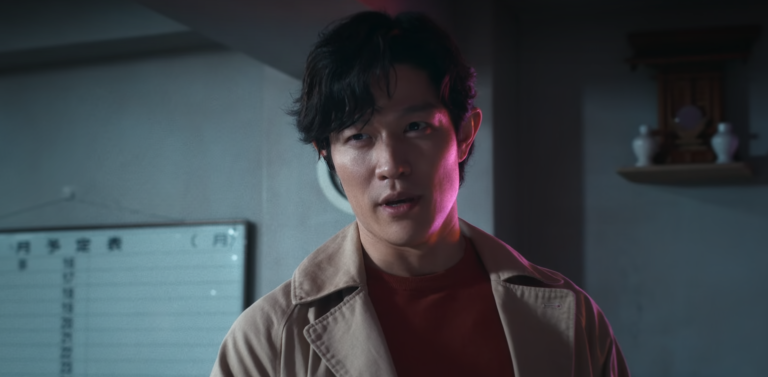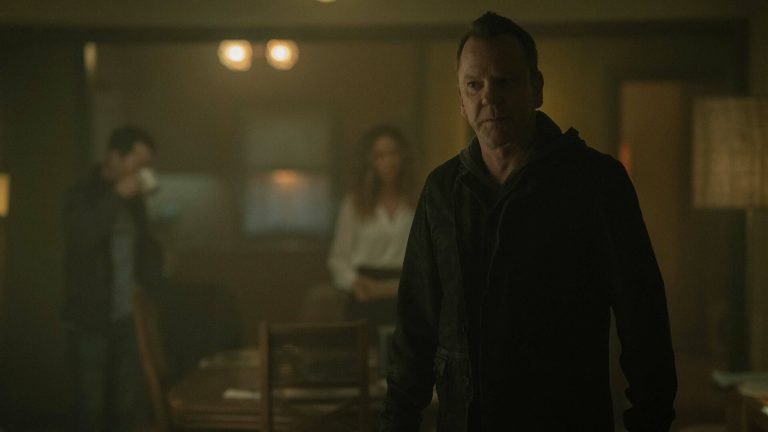If you are a new network launching a dedicated new streaming service, chances are that you will launch with an original series of your own. On December 20, 2022, the itvX streaming service was launched with “A Spy Among Friends,” a handsomely mounted, lavish-looking period piece spy thriller in the vein of Tinker Tailor, Soldier, Spy. It followed the story of Nicolas Elliott and Kim Philby, played by Damian Lewis and Guy Pearce, respectively, as officers of the SIS. Having been friends for over 23 years, both Elliott and the entire SIS suffer a huge blow once they realize that Philby had been a double agent for the Soviet Union for over 30 years.
Created by Alexander Cary (Homeland, Lie to Me), directed by Nick Murphy, and adapted from the non-fiction book of the same name by Ben McIntyre, A Spy Among Friends is structured as a Cold War thriller, very much playing into the slow burn treatment resembling Tomas Alfredson’s Tinker Tailor Soldier Spy or any of the other numerous John Le Carre novels.
But at its core, A Spy Among Friends is about two friends, the extent of their friendship for over two decades, and how both Elliott and Philby manage to navigate through the darkened alleys of espionage and counter-espionage, all the while Elliott is trying to salve his wounded heart and pride at not being able to identify the subterfuge, while Philby is trying to survive after defection. All the while, he is missing “jolly old England” and his best friend.
Recommended Read: The Spy Who Came in from the Cold (1965) Movie Ending, Explained
A Spy Among Friends (Miniseries) Recap:
Historical Context
One big criticism that could be attributed to “A Spy Among Friends” is a noticeable lack of historical context. To craft stylized storytelling full of time jumps with analepsis (flashback) and prolepsis (flash forward), the presentation becomes a muddled mess. Even with sprinkles of past events and events in Beirut intercut amidst the dual present-day storylines of both Elliott and Philby, it feels like showrunner Alexander Cary is imparting his story to an audience inundated with British history and 20th-century real-life spycraft.
The story of Kim Philby and the Cambridge Five is covered in British pop culture quite well. The 2003 miniseries titled “The Cambridge Spies” covers how a group of university students was recruited to spy for the Soviet Union in the 1930s, while Frederick Forsyth’s novel The Fourth Protocol features an elderly Kim Philby involved in a plot to trigger a nuclear explosion in Britain. The film adaptation of that novel features Michael Biehn as Kim Philby. Having said that, the historical context isn’t as prominent as the showrunner seems to think it is.
Who were the Cambridge Five?
The Cambridge Five was a group of British spies that operated from the 1930s through at least the early 1950s and provided information to the Soviet Union during the Second World War. No known participant has ever faced espionage charges. The ring’s size and membership gradually increased starting in the 1950s.
Donald Maclean and Guy Burgess’ abrupt departure from the Soviet Union in 1951 was the event that first brought the plot to the broader public’s attention. Harold “Kim” Philby, also known as Sonny or Stanley, who eventually escaped to the Soviet Union in 1963, came under obvious suspicion. In Episode 2, a segment in which Philby was questioned about his opinions on Burgess and Maclean’s betrayal was shown. In Episodes 5 and 6, Philby interacts with Guy Burgess. Burgess even visits Philby when the latter is admitted to the hospital after nearly being robbed by a beggar while intoxicated and lying on the stairs.
Following Philby’s flight, British intelligence obtained confessions from Anthony Blunt and then John Cairncross (cryptonym: Liszt), who have come to be seen as the last two of a group of five. Their involvement was kept secret for many years: until 1979 for Blunt and 1990 for Cairncross. The moniker Cambridge Four evolved to “Cambridge Five after Cairncross was added.
The phrase “Cambridge” alludes to the group’s recruiting while they were students at the University of Cambridge in the 1930s. The precise moment of their recruitment by Soviet intelligence is up for debate. According to Blunt, they weren’t hired as agents until after they received their degrees. Blunt, a Trinity College fellow and a few years older than Burgess, Maclean, and Philby, served as a recruiter and talent scout.
All five of the individuals were persuaded that Soviet communism’s Marxism-Leninism was the best political system to be a line of defense against the rise of fascism. They all pursued successful positions in different departments of the British government. They provided the Soviets with a lot of intelligence, so much so that the KGB began to suspect that at least some of it was bogus. The demoralizing impact of their slow unmasking on the British establishment and the resulting distrust in British security in the United States may have been just as significant as the intelligence they transmitted.
How did Kim Philby become enamored with and involved with the communist cause?
Kim Philby was drawn to communism and Marxism as a Cambridge student, and a Cambridge instructor made him conscious of the suffering of those who had fallen prey to German fascism. He met Litzi Friedmann, an Austrian communist when he assisted German refugees in Vienna in 1934. Kim and Litzi got married in February 1934 and immigrated to the UK two months later because Kim was fascinated by Litzi’s political beliefs and her fervor for saving persecuted Jews.
We are given glimpses of these events in Episode 2, which are fully explored in Episode 6 when Philby finally explains to Elliott where it all began. Philby was supposedly first introduced to Soviet intelligence by Litzi’s partner, Edith Tudor Hart, who was purported to be a Soviet agent. Later, it was discovered that Arnold Deutsch was searching for outstanding students at British universities, and Philby drew his attention. As a result, Deutsch hired Philby into Soviet intelligence.
After Philby arrived back in the UK, he started working as a freelancer and a field reporter for “The Times.” In reality, Philby wanted to enlist Flora Solomon, a friend, as a Soviet spy, but he was unable to do so without the Russian spymaster’s approval. Afterward, Philby met Aileen Furse, a friend Solomon had earlier introduced to him. Following the dissolution of his marriage to Litzi in 1946, he married Aileen.
On the other hand, his bond with Aileen did not last as long. Aileen struggled with her mental health issues until she died in 1957. We see in Episode 3 that Aileen voices her suspicions to Elliott that Philby might be having an affair, and while Elliott pooh-poohs that suspicion, he follows Philby to lunch at a pub with a woman.
In retrospect, Elliott believed that Kim already knew he was being followed. But his belief that Aileen’s suspicions were correct was proven naught when Philby confesses a few days later that he helped a woman escape the Nazis by “moving some papers” (faking a marriage). That explanation was enough for Nicholas to dissuade both Aileen and Flora from trusting Philby. Later, though, while reconstructing the events in his head, Elliott realizes that the woman Philby was meeting had been a Soviet agent.
In the 1940s, Philby was recruited by MI6 under Guy Burgess’ recommendation. In 1941, Philby was assigned to MI6’s Section Five, the Counterintelligence Department, and it was during this period he met James Jesus Angleton, who later became the CIA’s chief of counterintelligence. Angleton developed doubts about Philby after failing to give him intelligence about a British agent who the Nazis had killed, but Angleton’s worries were not properly considered.
Meanwhile, Konstantin Volkov, a Russian diplomat and NKVD agent wanted to inform the British Government about three Soviet agents working within Britain in exchange for a laissez-passer (travel document) for him and his wife and a sum of 27,500 pounds. He informed the British Government that two of these agents were working in the foreign office, while the third was the head of a counterespionage organization in London. The task of attending to this matter was regrettably sent to Kim Philby, who took charge of the situation and handed Volkov and his wife over to the Soviet agents. We are shown Volkov, and his wife captured and later shot by Soviet agents in “A Spy Among Friends.”
Around the same time as Philby moved to Washington, DC, Maclean came under British intelligence’s investigation, and his interrogation was scheduled for May 23, 1951. Burgess persisted, and as a result, Philby helped Maclean, and Burgess fled to Moscow. After returning to Britain, Philby was interrogated repeatedly and questioned whether he was the third member of Burgess and Maclean’s Soviet espionage ring.
All accusations and rumors were calmly refuted by Philby, who asserted that he had never been a communist or worked for the Soviet Union. He eventually quit MI6 in 1951 but was unable to find work anywhere, not even as a writer. His actions as a Soviet agent were also suspended. After being exonerated, he was let go by MI6 and Soviet intelligence. He was sent to Beirut in 1956, where he contributed to “The Observer” and “The Economist.” But at the time, Anatoliy Golitsyn, the chief directorate of the KGB, revealed Philby’s status as a Soviet double agent during a 1961 interrogation.
And this is when the “present” time frame of the story begins.
The inquiry begins
With Gositlyn’s testimony being verified by testimony from Mrs. Flora Solomon, the British Government fell into a helter-skelter to extract a full confession from Kim Philby and enquire about all Philby’s correspondence with the Soviet Union. The question of bureaucratic politics arises as to who takes over this investigation, SIS or MI5. SIS is finally chosen to lead this investigation because of their purview over foreign intelligence and the sensitivity of the situation.
Nicholas Elliott is chosen for this task because of his friendship with Philby, and he meets Philby in Beirut. After four days of rendezvous and supposed questioning at the safe house, Philby gives him a full written confession while also escaping. Thus, Elliott is called into questioning by MI5 as Philby escaped on his watch.
The entire conversation between Elliott and Philby is repeatedly analyzed because the safe house in Beirut has been bugged. Elliott’s vehement defense of Philby when Philby was suspicious of being involved in the escape of Burgess and Maclean, plus his answer that it was unbelievable that Philby would choose to side with the Russians than choose immunity for himself and his family”, seems a far more vapid and naive response from an experienced officer of a secret agency. Thus, suspicions over Nicholas Elliott’s shifting loyalties are valid.
But as the show progresses, we realize that Elliott’s first meeting with Philby induced a form of hero worship over Philby. Primarily because their meeting occurred one night during a party at the club when the bomb had impacted it. Elliott recalls it as the first night of the Blitz. The blitz was the bombing campaign undertaken by the Nazis against the United Kingdom in 1940 and 1941. What attracted Elliott to Philby’s charismatic aura was his unbothered attitude, even after he was almost trapped under rubble after the bombing, asking the bartender for a drink after having checked whether all his limbs were in one piece.
As we traverse through the show’s shifting timelines, we realize that Elliott is suffering from a complicated mixture of loyalty and betrayal. A friendship of over 20 years was broken by shifting allegiances in the geopolitical and ideological landscape, and we realize that Elliott was having a hard time accepting closure from that “heartbreak.” Friendship can have all the intensity of a love affair, as shown in “A Spy Among Friends.”
We see the same dilemma within a chameleon-like Kim Philby as well. As one of the key members of the Cambridge Five, Philby expected a warmer welcome than the suspicion and distrust he was subjected to. It could be attributed to the fact that he was never an official double agent, and thus the Kremlin had a harder time trusting Philby’s allegiances to the cause.
Meanwhile, James Jesus Angleton’s friendship with both Nicholas Elliott and Kim Philby is explored. However, Angleton’s friendship mirrors very much the “hero worship” Elliott explained to Lily Thomas he had also experienced. We also learn that Philby utilizes this friendship and hero worship of Angleton to leverage himself as a CIA asset for the KGB. “A Spy Among Friends” shows Angleton and his CIA subordinates following Philby, keeping watch on him, and trying to bring him to their side.
In a harrowing sequence, accompanied by gorgeous match cuts, Philby double-crosses the CIA and alerts the KGB to the safe house where the agents are watching. While Philby proves his loyalty to the Union, he is horrified at the KGB’s choice to kill the agents instead of using torture and subterfuge to question them.
The Lily Thomas of it all
Here’s where the show enters into dicey waters because the character of Lily Thomas (played with sublime alacrity by Anna Maxwell-Martin) is a composite of several real-life individuals but, at its core, is a fictional interviewer. It thus begs the question of whether a fictional character was needed to bring about a sense of closure to a story or to provide a commentary on the “boys club” nature of the secret services. Thomas’ character is almost the audience surrogate here because of her obvious contempt against this “diplomatic game” or mind games that are being played with ideologies at the forefront and constantly shifting.
Thomas’ character is also the quintessential portrayal of a strong woman dealing with her fair share of sexism in the workplace, with the share being far more overwhelming due to the period this show is set in. Her relationship with her husband is shown to be friendly and supportive. Still, it runs the risk of getting strained because of the secrets she shares due to her job and later getting involved in the entire rigmarole of this debacle with Nicholas.
Finding out that an American secret agent named Michael Whitney Straight has confessed to working for Soviet Intelligence in the 30s raises her eyebrows, especially when a parcel from the US Embassy is delivered near Elliott’s office. Realizing that Elliott might be planning something, she manages to get into the same private viewing of the Queen’s Gallery that Nick had also managed to enter after pulling some connections from his wife. She gets involved in a conversation with Elliott and Tony Blunt, where Elliott, in a “slip of the tongue,” mentions Vermehren instead of the painter Vermeer.
Both she and Elliott’s wife realize the subterfuge beneath the seemingly innocent statement. Later that night, when Thomas finally comes knocking at Elliott’s door and confronts him about the alleged slip-up, Elliott reveals that Vermehren is a “devout Catholic who detested Nazis.” The alleged slip-up is because Philby had revealed in Beirut to Elliott that Sir Tony Blunt was also a double agent, and his reaction on hearing the name Vermehren had confirmed it for Elliott.
Following that incident, the show is a step-by-step investigation and revelation of the different forces working in play: the CIA led by Angleton’s dogged pursuit of trying to convert Philby into a CIA asset and failing miserably at it and then trying to latch onto the same investigation of Lily Thomas upon realizing that Thomas is working with Elliott to uncover Blunt’s dual identity. It is a confusing, meandering mess that finally resolves itself in the same grassy knoll where Philby and Elliott had helped Vermehren to defect.
A Spy Among Friends (Miniseries) Ending, Explained:
Lily Thomas finally informs SIS that Philby had revealed to Elliott about Tony Blunt’s dealings with the Soviets. Elliott is finally called in and ordered to reveal the full extent of Philby’s confession. Nicholas Elliott reveals that he was wary of leaks within the agency after being betrayed by a friend he had valued for over 20 years. His wariness translated to him being dodgy and vapid when asked about that day.
Unlike what had been revealed in the previous episodes, Elliott and Philby had been thick as thieves for the four days that Nick had been in Beirut until the final night when Elliott had been invited to dinner at Philby’s house. The party had been in full swing, and perhaps realizing that his time was up, Philby had been belligerent towards his guests. The old British adage of bottling up feelings had been threatening to break, and Philby, realizing that his life of over 20 years, including his friendships, had all been burnt up in flames, finally gives his signed confession to Elliott.
Within the documents that Philby gave Elliott was the list of possible agents Nick had suspected and asked Philby to verify. Elliott sees that the names of Tony Blunt and Sir Roger Hollis have also been circled. It creates a tricky situation in the present day because Hollis was the head of SIS and is currently spearheading the inquiry against Elliott. Withholding the names of the two agents, especially that of Hollis, had been Elliott’s plan from the start to force Hollis to agree to his terms. It didn’t matter whether Hollis had been a double agent; the “game” depended on hearsay, and the power of information, and who wielded it, and Elliott leveraged that information to secure his job.
Meanwhile, back in Russia, Philby had been missing his friend, and previous events, as well as his deteriorating health due to his alcoholism, caused him to hallucinate and be hospitalized. Before the hospitalization, he wrote Elliott a letter asking for a last meeting. Back in the present, Elliott reveals to Thomas that he had received the letter and was seriously considering it, which makes her furious that he is again succumbing to the sentimentality of the friendship. Elliott gives a wan smile and agrees before stating that he had already gone to meet him.
He had followed Philby to the bar where he had been waiting, looked at him one final time through the “looking glass,” and then left, but not before leaving the umbrella Kim had gifted him on the sidewalk as a symbolic gesture of closure. He also reveals to Lily that he had effectively convinced Philby to run and defect; otherwise, Moscow would have had a hard time trusting him and might have killed him. As history tells us, Philby did retire to Moscow and never spied again. Nicholas Elliott, too retired with his reputation as the jokester of parties intact. At the same time, Sir Roger Hollis left MI5, and only later were the accusations of him being a double agent proven untrue.
Final Thoughts:
It soared when the show focused on the friendship between Philby and Elliott. Because A Spy Among Friends was always about friendship and the secrets friends choose to share and keep close to their vests, An exploration of the betrayer and the betrayed A Spy Among Friends shows the emotional torture both these men go through throughout the entirety of the story, made even more excruciating by the stiff upper lip nature of being British upper class.
The show falters excruciatingly in almost everything else regarding its storytelling. It talks like Le Carre, walks like Le Carre, and even looks like a Le Carre novel adaptation, but it mistakes convolution for complexity. The story would have worked wonders if the decision to use a non-linear format and break the timeline down into individual pieces of a jigsaw puzzle had been foregone.
A linear format of storytelling might have worked to explain the story far better because the visual muddiness of the filmmaking to convey a sense of seriousness and suspense only succeeds in alienating the audience from enjoyment. A slow-burn approach to an espionage story isn’t a bad thing, as any Le Carre adaptation would prove, but the fragmented approach of the storytelling did not help.
It also didn’t help that the context, especially those about the history of the true events, wasn’t conveyed satisfactorily. It thus lessened the impact of each of the revelations as they occurred. Although it helped that the performances and the consistency of the tone managed to make this show interesting during key moments, but being intrigued by figuring out and putting the pieces of this jigsaw puzzle together could only sustain for so long. This is one of those rare cases where the adaptation could actively hinder people from checking out the book, provided they were even interested in finishing this long, overstretched show in the first place. It’s a shame because the show looks great, and the period setting feels authentic.









